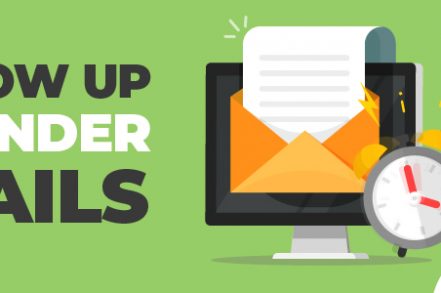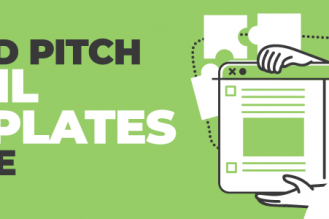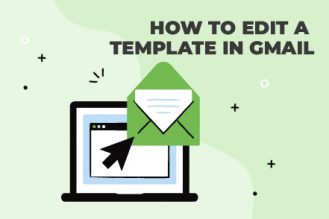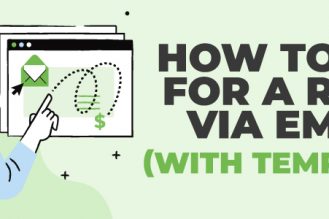You meet your prospect online or offline. You’d introduce yourself, make that small talk happen, and then wait for an opportunity to pitch. Learning the art of follow up emails will help get the deal over the line.
Savvy marketers would be subtle, of course. Some people and businesses do this exceptionally well. Is it art or attitude? Andy Paul of Salesforce blog takes a shot at trying to explain this, but we’d think that it’s an art that requires a certain kind of attitude.
Most business owners with an inclination to sell, professional sales people, jobseekers, link outreach builders and pretty much everyone else have to follow up every once in a while. It’s about reminding your prospects or recipients that you exist. It’s about plugging into a routine drill to keep reminding others of the value proposition you have to offer.
There’s an art and science to sending a powerful follow-up message. So let’s talk about email follow-up tactics and strategies you can implement right now.
Sending follow up messages has been happening forever, and it’ll continue to do so.
*** SUPERCHARGE Your Gmail account with this FREE chrome extension ***
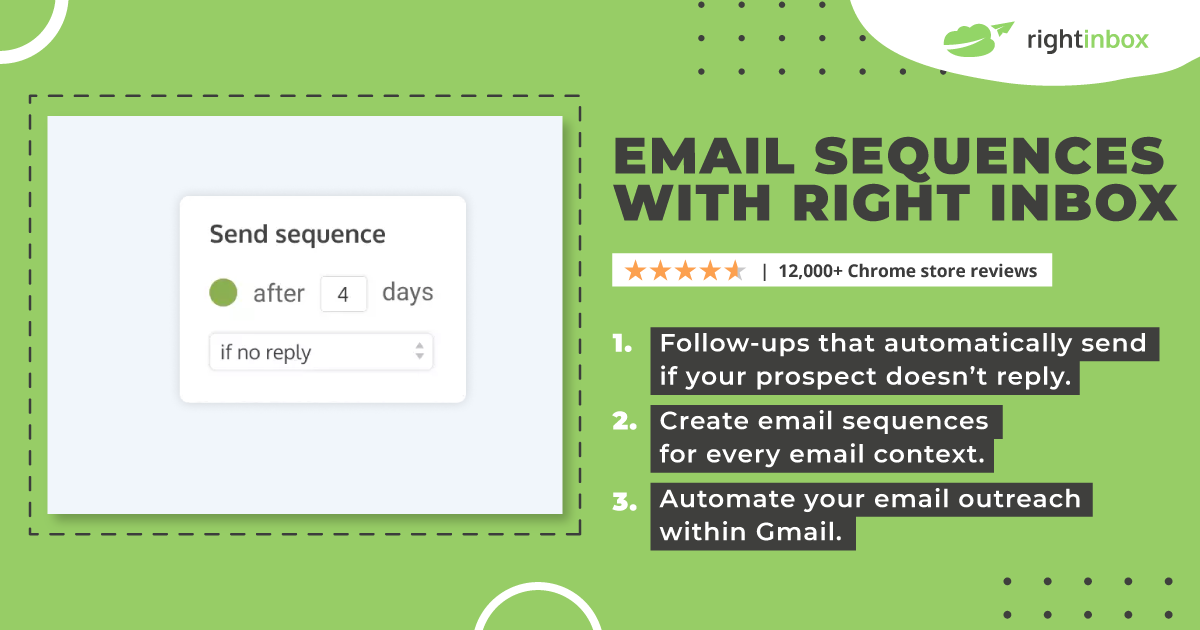
Here are a few examples of follow up emails that we created with a few hypothetical scenarios. The tone, attitude, and the soft-pitches: it’s all here:
How Long Should You Wait Before Following Up?
Remember that old dating rule of thumb – wait three days before calling to ask them out again? Well, while that rule should disappear from the dating scene in favor of quicker follow-up texts, it still applies to business email follow-ups.
Two to three days is actually a good amount of time to wait before making your first follow-up. It’s long enough to indicate that your prospect has missed responding back to your email, but not so long that you’re completely out of sight, out of mind.
If that first follow-up doesn’t tender a response, don’t give up. Statistics show that persistence pays when it comes to email follow-up. In fact, many prospects don’t say yes even on the second, third or fourth follow-ups.
Does that mean they’re a lost cause? Surprisingly, it doesn’t; research indicates that many prospects actually seal the deal after the sixth email in your follow-up chain.
Follow-Up Email Best Practices
Generally, a follow-up email should be concise and positive in tone. Focus on showing a different aspect of the product/service you provide, and, most importantly, how it benefits the prospect and solves a pain point.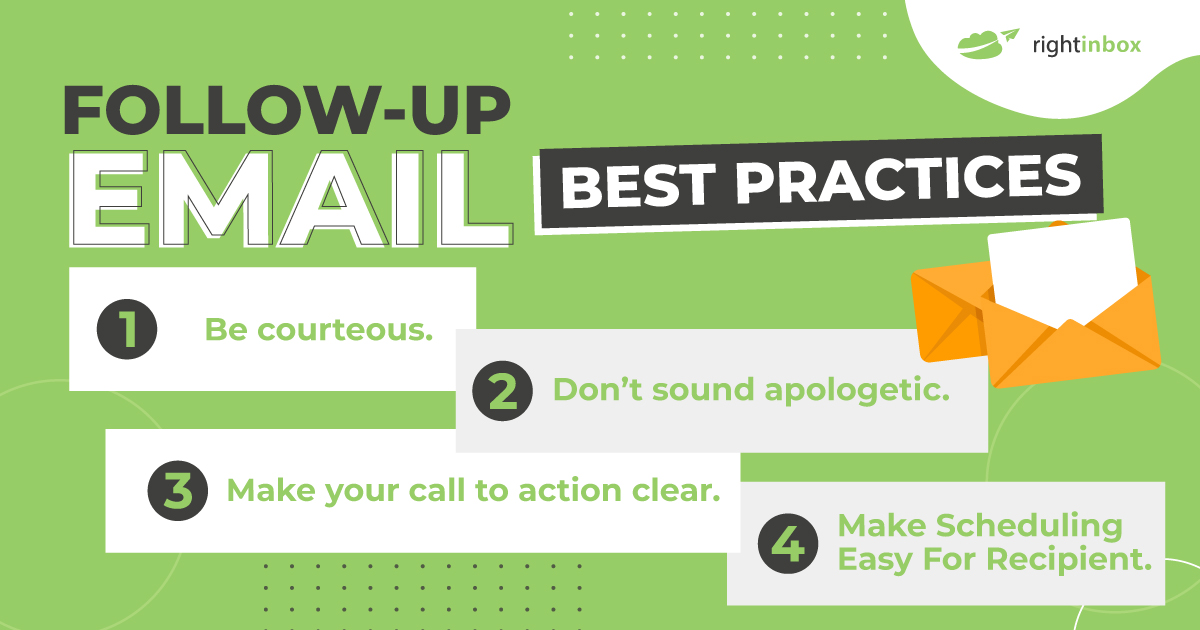
1. Be courteous:
Sometimes people don’t respond to your emails because they’re busy, they’ve forgotten or they didn’t see it the first time. Other times, they know when they’ve skipped responding to an email from you, or when they’ve decided to ghost you. Regardless, there’s no need for a passive-aggressive tone regarding their lack of follow-up; that approach isn’t beneficial to you or to them.
Instead, keep your tone helpful and upbeat. Telling them that you are “Just following up” indicates that they lapsed in their communications with you; saying you “Wanted to share about article about X (topic that relates to their business)” indicates that you’re interested in them and looking out for their best interests.
2. Don’t sound apologetic:
When you’re sending a follow-up, you should be doing it because you have something of value to say or share. If you don’t, you should reconsider sending the email.
If you do send it, there’s no need to include passive verbiage like, “I hope this is a good time,” or “Just checking in to see if you received my last email.”
3. Make your call to action clear:
Emails with a clear call to action perform better than those with multiple or ambiguous calls to action. Let the prospect know what step you’d like them to take, whether it’s downloading a case study, scheduling a follow-up call or setting up a demo.
4. Make Scheduling Easy For Recipient:
To get traction with your call to action and follow-up message, it helps to provide an easy way for them to take the next step by scheduling an appointment with you.
For example, you can embed a link that takes them to an appointment calendar where they can select a day and time to meet with you. Then, they can receive an email confirmation with the date or time or a feature that lets them click and add the appointment directly to their digital calendar app.
Additional Reading: How to Write a Follow Up Email [2024 Ultimate Guide]
What to Include in a Follow-Up Email – 11 Examples
Writing a good follow-up email is about more than just reminding the prospect you exist. It’s about continuing to promote the correct message.
Your follow-up emails should provide context and value; in other words, they should remind your prospects what your product is and why your product matters.
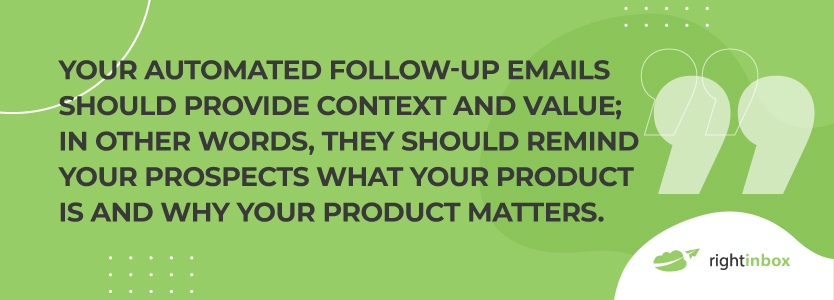
We’ve put together 11 examples of follow-up emails you can customize to fit your situation:
1. Reminder for an upcoming social event
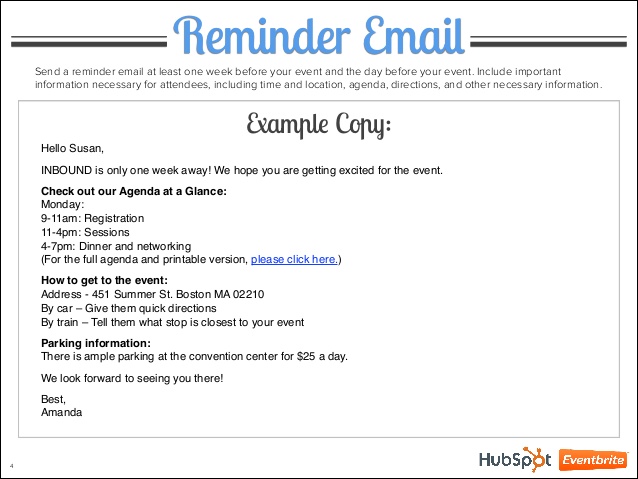
Hi Andy,
We’d like to thank you for signing up for our upcoming event.
Your presence will make a difference. I know the kids will be so excited to see you there and to see how many people care about their futures.
I wanted to send you the directions to the venue and give you a little tip – parking is always crowded, but the lot on the west side of the building seems to be the most open.
If you have any questions in the meantime, don’t hesitate to email me at event@yourlovelyevent.com or call me at XX XXXX XXX
Ready to spend the evening caring and sharing with you and all those wonderful families – see you soon!
Melissa
2. Follow-up example for cold emails
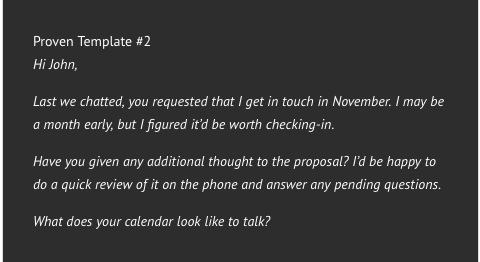
Hey Maurice,
I reached out recently with a website design proposal. I am a big fan of your business and a frequent shopper on your ecommerce site, which gives me some valuable insight into the user experience when interacting with your business online.
My proposal shared some details about my experience but I wanted to also send you an example that could relate really well to your business. I worked with an online stationery store to update their site and make it easy to buy with one-touch purchases, which led to a 20% increase in online sales during the first quarter after the update.
I could see something like this working really well with your business too. Could I call you next week to discuss or send you some links to sites that I’ve built, along with success stories?
Best regards,
John
3. From a freelancer to a client
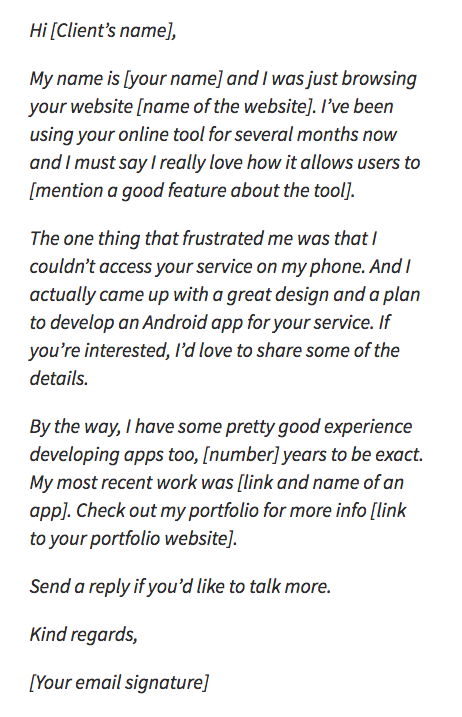
Hi Nicole,
A few weeks ago, I sent in a query with a couple of feature article ideas to write for your magazine. As I mentioned earlier, I have my sources lined up for interviews and I already have my preliminary research ready.
I wanted to share that I have time available in my calendar for additional ideation or for getting started on an article, if that works for you. If you’d like to suggest alternative approaches to my topic or title suggestions, please let me know and I’ll gladly send some additional ideas.
Best wishes,
Claire
4. Polite follow-up email
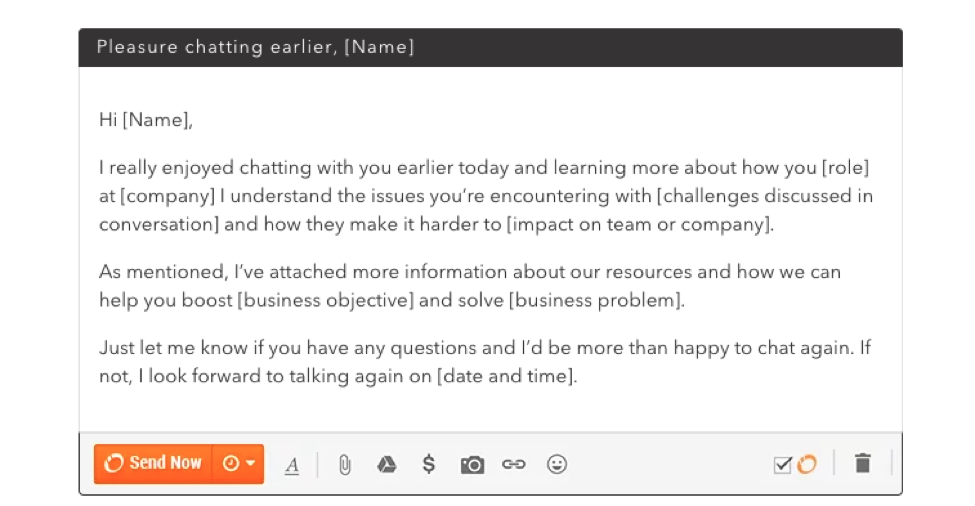
Hi Kate,
After our last conversation, I saw this article on LinkedIn regarding chatbots and their impact on the credit card industry. I am sharing the link (here) in hopes that we can continue our discussion on how our AI chat solution could similarly benefit your team, and solve some of the challenges faced by your chat representatives.
I’d be interested to hear what you think about the article – can we schedule a call to talk about it and about your business next week?
Regards,
William
5. Follow-up email to client
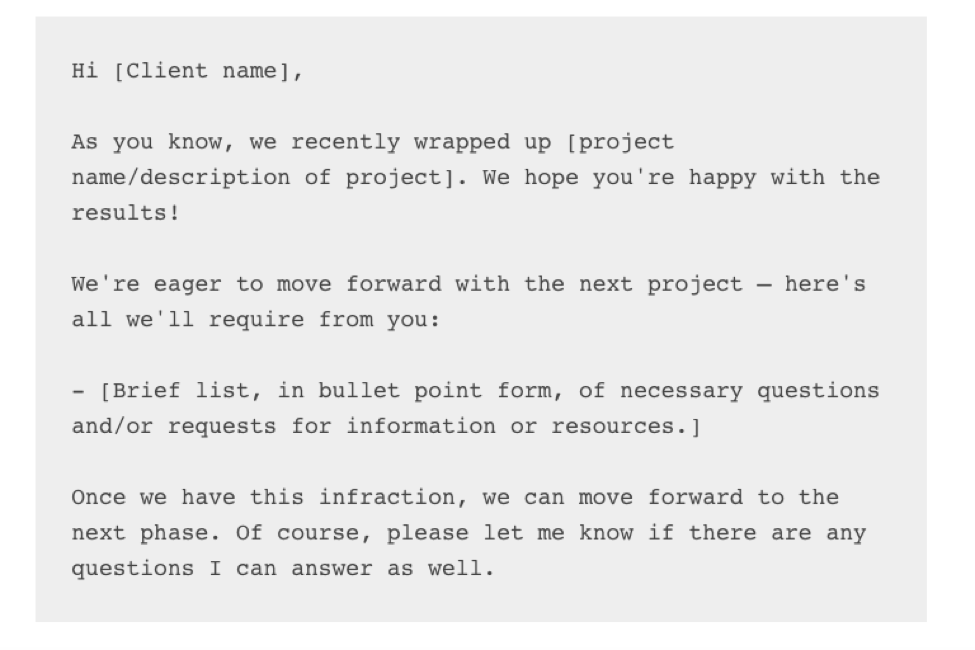
Hi Juliet,
It’s been really great to see the progress we’ve made on the capital campaign. With the numbers we’re seeing now, I think it’s worth looking at a few opportunities to supercharge our fundraising success rates.
When we last emailed, I mentioned the social media challenge I put together for another client. I wanted to share a link to their YouTube channel, where you can see the final recap of our efforts.
I’d love to talk more about implementing something similar for the Despereaux project. Can we discuss later this week?
Thanks,
Shawn
6. Follow-up email after interview
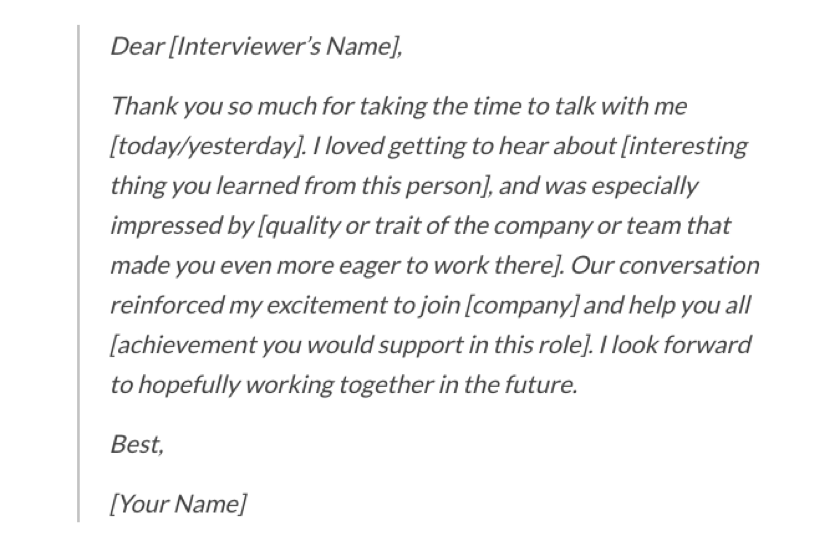
Dear Mr. Dean,
I really appreciated the opportunity to talk with you this week. I enjoyed hearing about your company’s vision and know that I could contribute to your ongoing success.
In the interview, we briefly discussed your desire to improve your online presence. I wanted to share some stats (attached) about the website redesign I led while working for XYZ and how it benefited the company.
Can I follow up with you again next week to see if you’ve made a decision on the candidates?
Looking forward to talking soon,
Amanda Hanson
7. Follow-up email after career fair
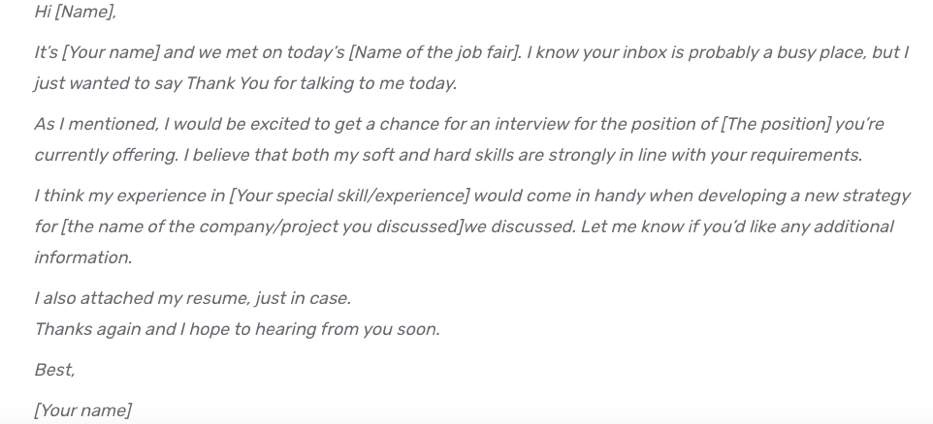
Dear Ms. Kelly,
A career fair is always so full of people, it can be hard to keep track of everyone you meet. However, your booth definitely stood out to me because of how friendly your team was, and because of how much I admire your company.
I am sure you received many business cards at the event; I wanted to make sure my information made it into your inbox as well. I’m including a copy of my resume and a link to my LinkedIn profile.
I’d appreciate the chance to connect with you in the future about career opportunities at your company. Would you be available for a short phone call or a cup of coffee?
Hope to talk soon,
Meghan Jones
8. Communication Has Stopped Altogether
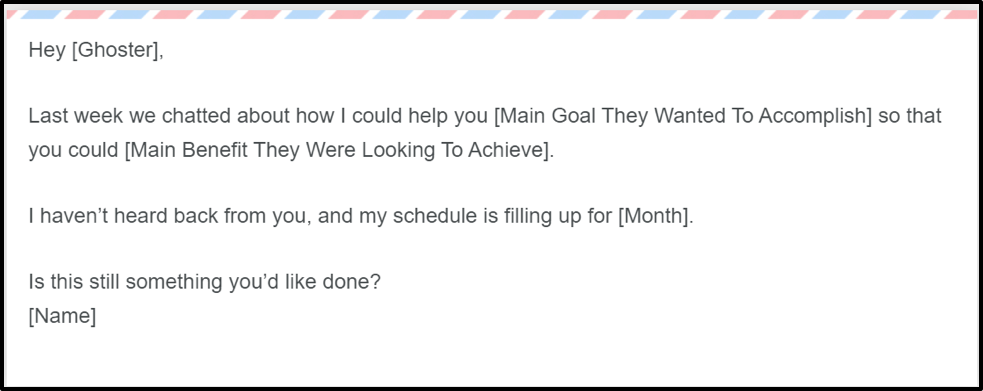
Hi Jenny,
It’s been a while since I last heard from you.
When we last talked, we discussed the various ways in which we could help you grow your contact database and improve the reach of your marketing campaigns. We also spoke about meeting in person to explore various working arrangements.
Let me know if you’d like to move forward so we can get something on the calendar for this month.
Kind regards,
Alice
9. Follow Up After a Call
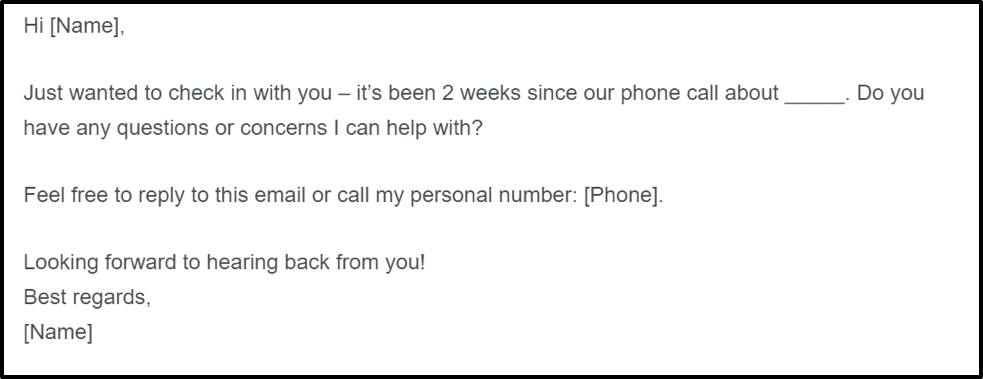
Hi Matt,
It was great talking to you on the phone earlier.
Sounds like you have a lot on your plate at the moment, so if you need anything from me to help ease your load then please reach out. You can drop me an email or call me on my cell.
How are you getting on with the content calendar?
Best wishes,
Helen
10. Status-Checking
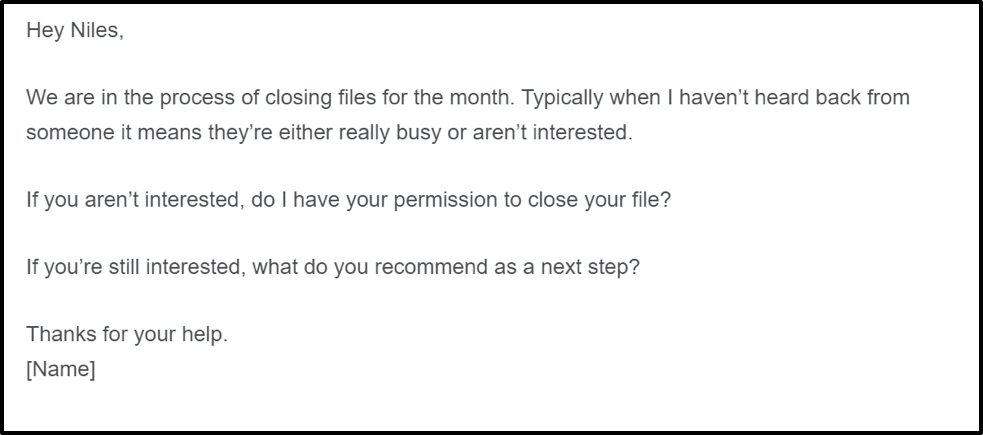
Dear Jeanette,
Just checking in to see if you’d given any more thought to the deal we discussed when we met on July 25th.
We’ll need to close your account if you’re no longer interested, so would you mind indicating where you stand?
If you’re no longer interested, please confirm that we can go ahead and close your account.
If you’re still interested, please let me know if you have any questions or need any further information for me at this stage.
Thanks in advance,
Lisa
11. Recap Email
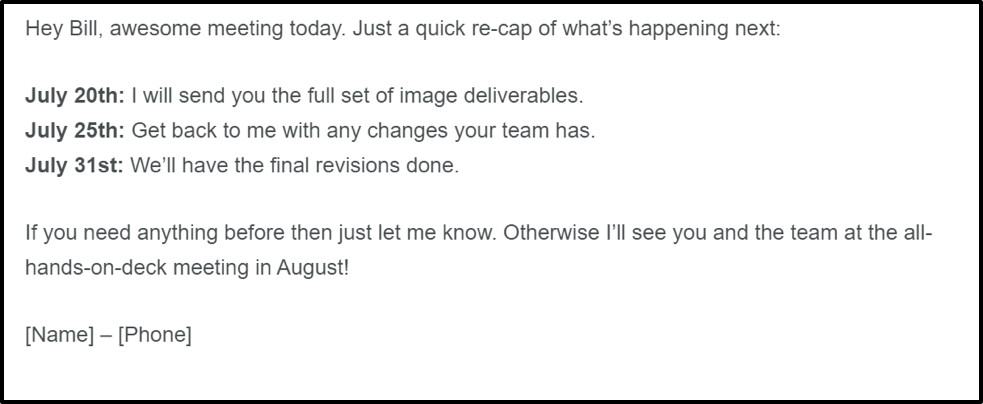
Hey John,
Great meeting today. I think we made good progress with [project name], and I look forward to making headway over the next few weeks.
Here’s a quick recap of the next steps:
April 2nd: I will send you X file.
April 9th: You will provide me with details on Y.
April 23rd: We’ll meet again to make revisions and to finalize the project (venue TBC).
April 30th: We deliver the final project to partners.
Should you need anything from me, please feel free to drop me a line. For anything urgent, you can call my cell (number in my signature below).
Thanks!
Craig
12. Staying In Touch
Hi Jill,
Just circling back after our interview. It was great learning about your company and the role available.
When would be a good time to discuss it in a bit more detail this coming week?
Thanks,
John
13. Gentle Mention
Hey Chad,
Just wanted to let you know I’m pretty free this week after the conference ended. So I’m happy to hop on that call we talked about to catch up.
You can reach me at xxx-xxx-xxxx. Speak with you soon at your convenience!
Regards,
Sally
14. Stay In Touch
Hi Carl,
The conversations we had were quite fruitful. I’d love to keep them going and learn more about how I could potentially help ABC Industries boost their revenue.
If you have just a block of 15 minutes this week that would be excellent. Looking forward to staying in touch.
Warm regards,
Ken
Additional Reading: How to Send a Reminder Email
In case you haven’t noticed, none of the emails are too wordy. You’d get right to the point. No extra words, no waffling, and absolutely no rushing your prospects, clients, or your recipients.
Automatically follow-up with prospects that don’t reply to your first email with Right Inbox email sequences feature.
The charm of effective follow-up emails lies in brevity, personality, time and precision. Be sure your up to date on the best time to send an email as well. Of course, you could plug in your own style. Don’t forget A/B testing the follow-up email subject line.
When it comes to sending follow-up emails, don’t be afraid to show some personality. If you have a special email closing you like to use, like “Best” or “Warmly,” it can be a nice way to infuse a little personality into your email.
Be careful not to go overboard, though. A little quirkiness is fine; too much, and you run the risk of sounding unprofessional.Be sure to check out our email templates hub for over 100+ email templates to improve your follow up email efforts.
Follow Up Emails Frequently Asked Questions (FAQs)
What’s an example of a follow-up email?
We have 11 excellent examples that you can follow word for word above.
How do you professionally send a follow-up email?
There are a few things to keep in mind. Watch your tone, create a compelling subject line, and keep it short and to the point. From here, it’s a good idea to also add an email signature.
How do I include an email signature in my follow-up emails?
You can use an application like RightInbox to automate email signatures with every email that you send.
Can I automate follow-up email sequences?
Yes. RightInbox allows you to create email follow-up templates and even send them out at scheduled times. For instance, you can have them automatically sent based on the response or after a set period of time.
When’s the best time to send a follow-up email?
It depends on the context of the initial email conversation. For instance, if you’re reminding someone to finish purchasing a product they added to their cart, the sooner the better.
On the other hand, if you’re sending a reminder email for an unpaid invoice, leaving your client a grace period is a nice professional touch.
Track emails, email reminders & templates in Gmail for free
Upgrade Gmail with the features it’s missing
Add to GmailDavid Campbell
David Campbell is the editor of the Right Inbox blog. He is passionate about email productivity and getting more done in less time.
